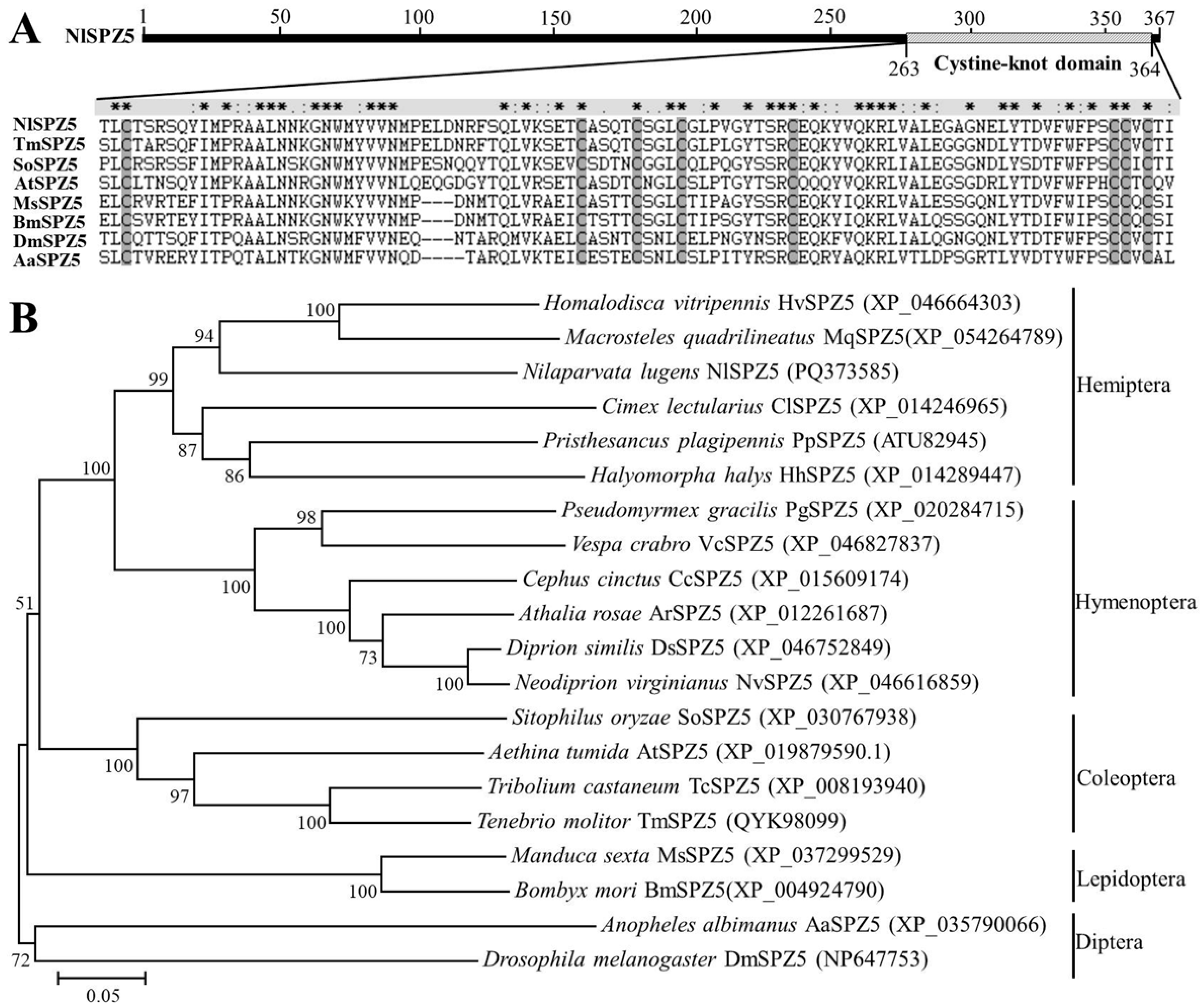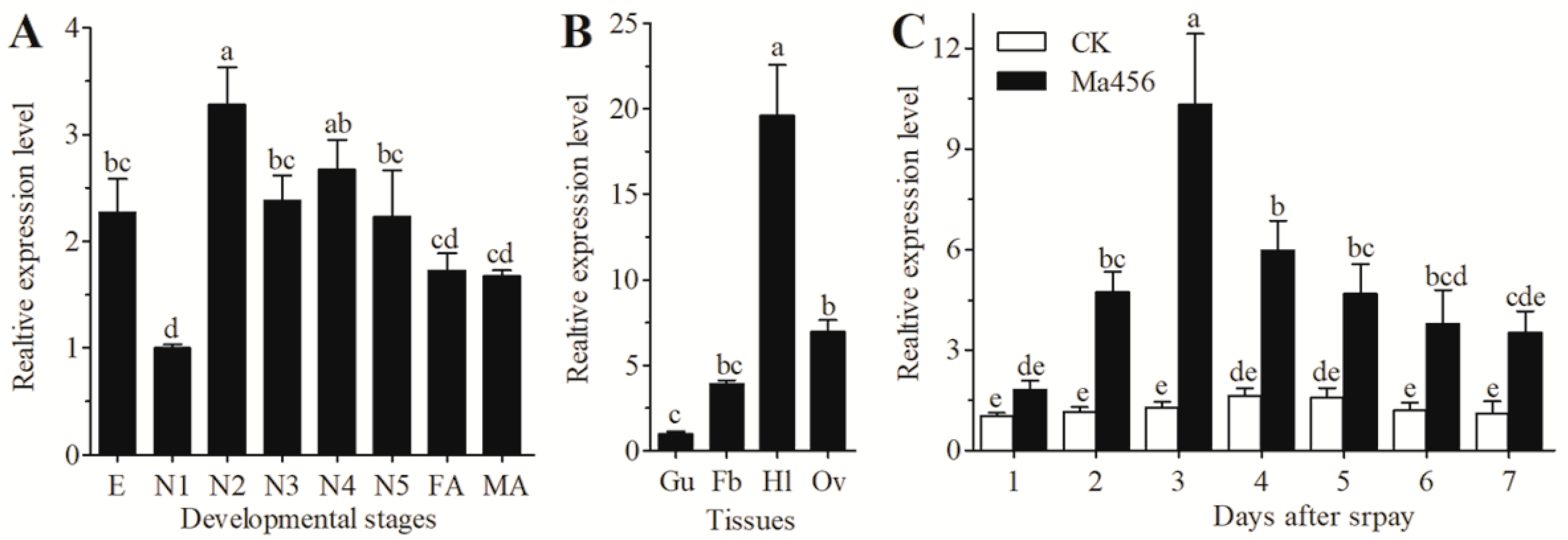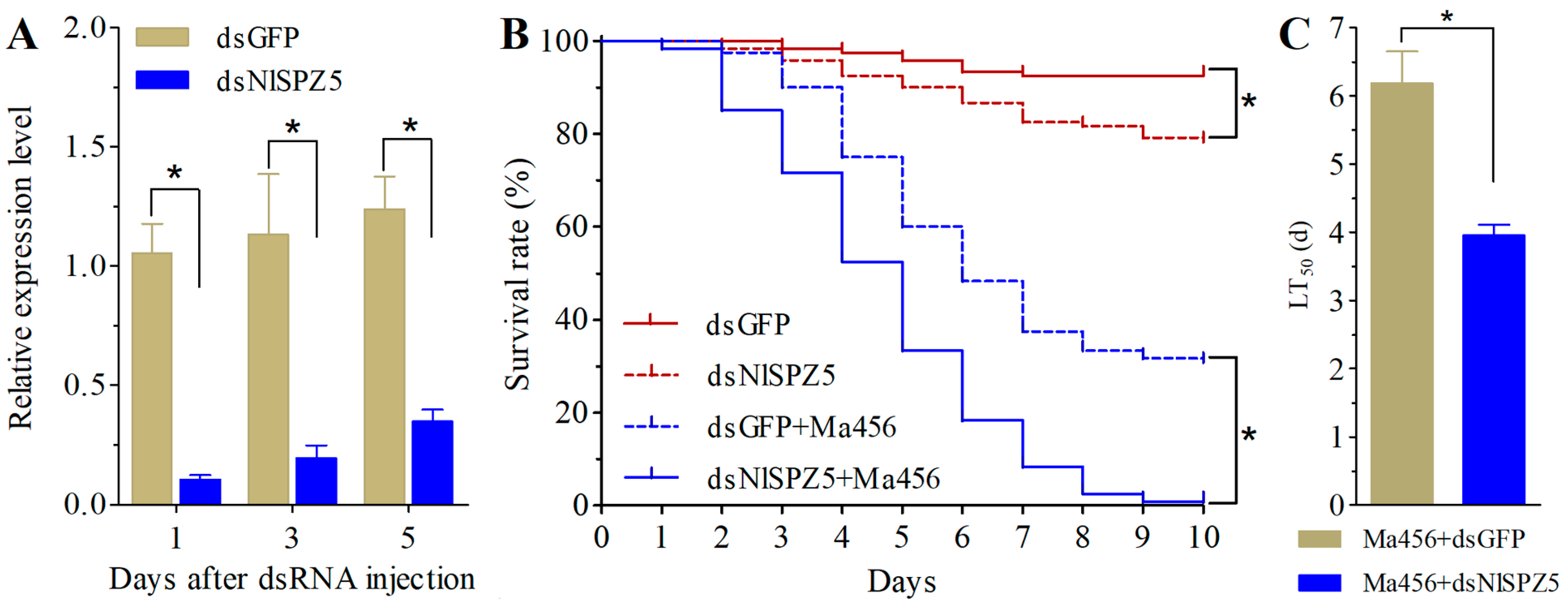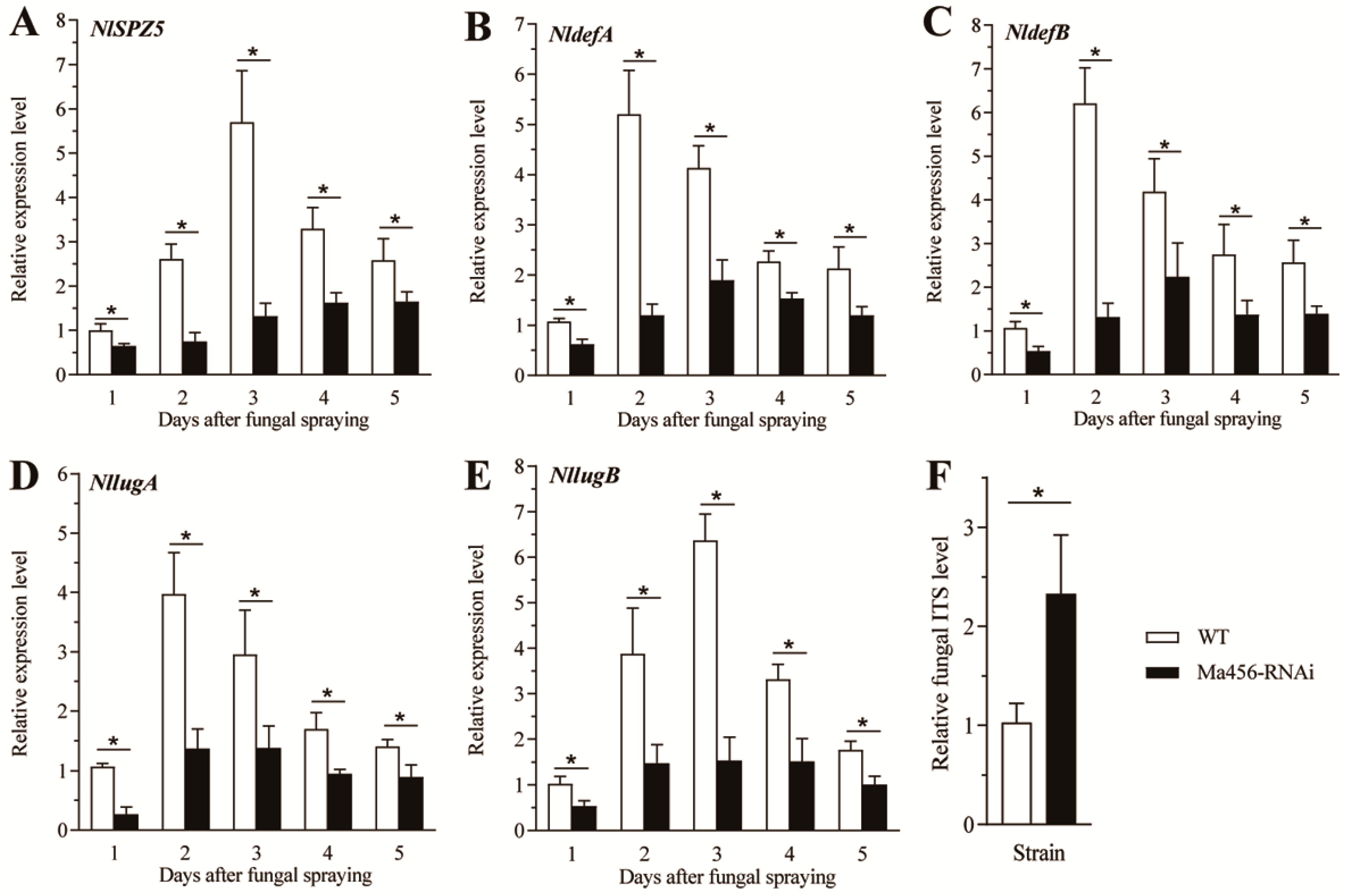Enhancing the Virulence of a Fungal Entomopathogen Against the Brown Planthopper by Expressing dsRNA to Suppress Host Immune Defenses
Abstract
1. Introduction
2. Materials and Methods
2.1. Fungal Strains and Insect Stock
2.2. Gene Cloning and Characterization of NlSPZ5
2.3. Quantitative Real-Time PCR (qRT-PCR) Analysis of NlSPZ5
2.4. RNAi and Bioassays
2.5. Expression Vector Construction and Fungal Transformation
2.6. Phenotypic Analyses of Transgenic Fungal Strains
2.7. Statistical Analysis
3. Results
3.1. Features of the NlSPZ5 Gene and the Deduced Amino Acid Sequence
3.2. Expression Patterns of the NlSPZ5 Gene
3.3. NlSPZ5 Gene Silencing Increased BPH Susceptibility to Fungal Infection
3.4. Transgenic Fungus Expressed dsRNA of the NlSPZ5 Gene
3.5. Biological Evaluation of the Transgenic Fungal Strain
3.6. Virulence of the Transgenic Fungal Strain Against BPH
3.7. Repressed NlSPZ5 Expression in BPH Infected by Transgenic Fungal Strain
3.8. Reduced Antifungal Defense in BPH Infected by Transgenic Fungal Strain
4. Discussion
5. Conclusions
Supplementary Materials
Author Contributions
Funding
Institutional Review Board Statement
Informed Consent Statement
Data Availability Statement
Conflicts of Interest
References
- Cheng, X.; Zhu, L.; He, G. Towards understanding of molecular interactions between rice and the brown planthopper. Mol. Plant 2013, 6, 621–634. [Google Scholar] [CrossRef] [PubMed]
- Bao, Y.; Zhang, C. Recent advances in molecular biology research of a rice pest, the brown planthopper. J. Integr. Agr. 2019, 18, 716–728. [Google Scholar] [CrossRef]
- Diptaningsari, D.; Trisyono, Y.A.; Purwantoro, A.; Wijonarko, A. Inheritance and realized heritability of resistance to imidacloprid in the brown planthopper, Nilaparvata lugens (Hemiptera: Delphacidae), from Indonesia. J. Econ. Entomol. 2019, 112, 1831–1837. [Google Scholar] [CrossRef]
- Liao, X.; Xu, P.F.; Gong, P.P.; Wan, H.; Li, J.H. Current susceptibilities of brown planthopper Nilaparvata lugens to triflumezopyrim and other frequently used insecticides in China. Insect Sci. 2021, 28, 115–126. [Google Scholar] [CrossRef] [PubMed]
- Lacey, L.A.; Grzywacz, D.; Shapiro-Ilan, D.I.; Frutos, R.; Brownbridge, M.; Goettel, M.S. Insect pathogens as biological control agents: Back to the future. J. Invertebr. Pathol. 2015, 132, 1–41. [Google Scholar] [CrossRef]
- Li, M.Y.; Li, S.G.; Xu, A.M.; Lin, H.F.; Chen, D.X.; Wang, H. Selection of Beauveria isolates pathogenic to adults of Nilaparvata lugens. J. Insect Sci. 2014, 14, 32. [Google Scholar] [PubMed]
- Wang, Z.L.; Pan, H.B.; Li, M.Y.; Wu, W.; Yu, X.P. Comprehensive insights into host-pathogen interaction between brown planthopper and a fungal entomopathogen by dual RNA sequencing. Pest Manag. Sci. 2021, 77, 4903–4914. [Google Scholar] [CrossRef]
- Zhao, Q.; Ye, L.; Wang, Z.L.; Li, Y.F.; Zhang, Y.; Keyhani, N.O.; Huang, Z. Sustainable control of the rice pest, Nilaparvata lugens, using the entomopathogenic fungus Isaria javanica. Pest Manag. Sci. 2021, 77, 1452–1464. [Google Scholar] [CrossRef]
- Butt, T.M.; Coates, C.J.; Dubovskiy, I.M.; Ratcliffe, N.A. Entomopathogenic fungi: New insights into host-pathogen interactions. Adv. Genet. 2016, 94, 307–364. [Google Scholar]
- Lu, H.L.; St Leger, R.J. Insect immunity to entomopathogenic fungi. Adv. Genet. 2016, 94, 251–285. [Google Scholar]
- Yu, S.J.; Pan, Q.; Luo, R.; Wang, C.L.; Cheng, L.Y.; Yang, J.S.; Zhou, H.N.; Hou, D.Y.; Liu, H.Q.; Ran, C. Expression of exogenous dsRNA by Lecanicillium attenuatum enhances its virulence to Dialeurodes citri. Pest Manag. Sci. 2019, 75, 1014–1023. [Google Scholar] [CrossRef]
- Zhang, W.; Keyhani, N.O.; Zhang, H.; Cai, K.; Xia, Y. Inhibitor of apoptosis-1 gene as a potential target for pest control and its involvement in immune regulation during fungal infection. Pest Manag. Sci. 2020, 76, 1831–1840. [Google Scholar] [CrossRef] [PubMed]
- Moreira-Pinto, C.E.; Coelho, R.R.; Leite, A.G.B.; Silveira, D.A.; De Souza, D.A.; Lopes, R.B.; Macedo, L.L.P.; Silva, M.C.M.; Ribeiro, T.P.; Morgante, C.V.; et al. Increasing Anthonomus grandis susceptibility to Metarhizium anisopliae through RNAi-induced AgraRelish knockdown: A perspective to combine biocontrol and biotechnology. Pest Manag. Sci. 2021, 77, 4054–4063. [Google Scholar] [CrossRef]
- Yang, L.; Keyhani, N.O.; Tang, G.; Tian, C.; Lu, R.; Wang, X.; Pei, Y.; Fan, Y. Expression of a toll signaling regulator serpin in a mycoinsecticide for increased virulence. Appl. Environ. Microbiol. 2014, 80, 4531–4539. [Google Scholar] [CrossRef] [PubMed]
- Liu, S.; Jaouannet, M.; Dempsey, D.A.; Imani, J.; Coustau, C.; Kogel, K.H. RNA-based technologies for insect control in plant production. Biotechnol. Adv. 2020, 39, 10746. [Google Scholar] [CrossRef]
- Mamta, B.; Rajam, M.V. RNAi technology: A new platform for crop pest control. Physiol. Mol. Biol. Plants 2017, 23, 487–501. [Google Scholar] [CrossRef] [PubMed]
- Adeyinka, O.S.; Riaz, S.; Toufiq, N.; Yousaf, I.; Bhatti, M.U.; Batcho, A.; Olajide, A.A.; Nasir, I.A.; Tabassum, B. Advances in exogenous RNA delivery techniques for RNAi-mediated pest control. Mol. Biol. Rep. 2020, 47, 6309–6319. [Google Scholar] [CrossRef]
- Li, X.; Liu, X.; Lu, W.; Yin, X.; An, S. Application progress of plant-mediated RNAi in pest control. Front. Bioeng. Biotechnol. 2022, 10, 963026. [Google Scholar] [CrossRef]
- Silver, K.; Cooper, A.M.; Zhu, K.Y. Strategies for enhancing the efficiency of RNA interference in insects. Pest Manag. Sci. 2021, 77, 2645–2658. [Google Scholar] [CrossRef]
- Chen, X.; Li, L.; Hu, Q.; Zhang, B.; Wu, W.; Jin, F.; Jiang, J. Expression of dsRNA in recombinant Isaria fumosorosea strain targets the TLR7 gene in Bemisia tabaci. BMC Biotechnol. 2015, 15, 64. [Google Scholar] [CrossRef]
- Hu, J.; Xia, Y. Increased virulence in the locust-specific fungal pathogen Metarhizium acridum expressing dsRNAs targeting the host F1F0-ATPase subunit genes. Pest Manag. Sci. 2019, 75, 180–186. [Google Scholar] [CrossRef]
- Wang, Y.; Xie, X.; Qin, L.; Yu, D.; Wang, Z.; Huang, B. Integration of dsRNA against host immune response genes augments the virulence of transgenic Metarhizium robertsii strains in insect pest species. Microb. Biotechnol. 2021, 14, 1433–1444. [Google Scholar] [CrossRef]
- Hu, J.; Cui, H.; Hong, M.; Xia, Y.; Zhang, W. The Metarhizium anisopliae strains expressing dsRNA of the NlCHSA enhance virulence to the brown planthopper Nilaparvata lugens. Agriculture 2022, 12, 1393. [Google Scholar] [CrossRef]
- Lemaitre, B.; Nicolas, E.; Michaut, L.; Reichhart, J.M.; Hoffmann, J.A. The dorsoventral regulatory gene cassette spätzle/Toll/cactus controls the potent antifungal response in Drosophila adults. Cell 1996, 86, 973–983. [Google Scholar] [CrossRef]
- Christophides, G.K.; Zdobnov, E.; Barillas-Mury, C.; Birney, E.; Blandin, S.; Blass, C.; Brey, P.T.; Collins, F.H.; Danielli, A.; Dimopoulos, G.; et al. Immunity-related genes and gene families in Anopheles gambiae. Science 2002, 298, 159–165. [Google Scholar] [CrossRef] [PubMed]
- An, C.; Jiang, H.; Kanost, M.R. Proteolytic activation and function of the cytokine Spätzle in the innate immune response of a lepidopteran insect, Manduca sexta. FEBS J. 2010, 277, 148–162. [Google Scholar] [CrossRef] [PubMed]
- Yu, B.; Sang, Q.; Pan, G.; Li, C.; Zhou, Z. A Toll-Spätzle pathway in the immune response of Bombyx mori. Insects 2020, 11, 586. [Google Scholar] [CrossRef]
- Ali Mohammadie Kojour, M.; Edosa, T.T.; Jangm, H.A.; Keshavarzm, M.; Jo, Y.H.; Han, Y.S. Critical roles of Spätzle5 in antimicrobial peptide production against Escherichia coli in Tenebrio molitor Malpighian tubules. Front. Immunol. 2021, 12, 760475. [Google Scholar] [CrossRef] [PubMed]
- Kumar, S.; Stecher, G.; Li, M.; Knyaz, C.; Tamura, K. MEGA X: Molecular evolutionary genetics analysis across computing platforms. Mol. Biol. Evol. 2018, 35, 1547–1549. [Google Scholar] [CrossRef] [PubMed]
- Livak, K.J.; Schmittgen, T.D. Analysis of relative gene expression data using real-time quantitative PCR and the 2(-Delta Delta C(T)) method. Methods 2001, 25, 402–408. [Google Scholar] [CrossRef]
- Wang, Z.L.; Zhang, L.B.; Ying, S.H.; Feng, M.G. Catalases play differentiated roles in the adaptation of a fungal entomopathogen to environmental stresses. Environ. Microbiol. 2013, 15, 21409–21418. [Google Scholar] [CrossRef]
- Tang, Q.Y.; Zhang, C.X. Data processing system (DPS) software with experimental design, statistical analysis and data mining developed for use in entomological research. Insect Sci. 2013, 20, 254–260. [Google Scholar] [CrossRef]
- Zhang, J.; Ye, C.; Wang, Z.G.; Ding, B.Y.; Smagghe, G.; Zhang, Y.; Niu, J.; Wang, J.J. DsRNAs spray enhanced the virulence of entomopathogenic fungi Beauveria bassiana in aphid control. J. Pest Sci. 2023, 96, 241–251. [Google Scholar] [CrossRef]
- Wang, C.; Wang, S. Insect pathogenic fungi: Genomics, molecular interactions, and genetic improvements. Annu. Rev. Entomol. 2017, 62, 73–90. [Google Scholar] [CrossRef] [PubMed]
- Kato, D.; Miura, K.; Yokoi, K. Analysis of the Toll and Spaetzle genes involved in Toll pathway dependent antimicrobial gene induction in the red flour beetle, Tribolium castaneum (Coleoptera; Tenebrionidae). Int. J. Mol. Sci. 2023, 24, 1523. [Google Scholar] [CrossRef]
- Han, P.; Chen, D.; Fan, J.; Zhang, J.; Jiang, S.; Zhu, K.Y.; Zhang, J. Genetically engineered Metarhizium anisopliae expressing dsRNA of Apolipophorin-D exhibits enhanced insecticidal virulence against Locusta migratoria. Entomol. Gen. 2023, 43, 167–175. [Google Scholar] [CrossRef]
- Mehlhorn, S.; Hunnekuhl, V.S.; Geibel, S.; Nauen, R.; Bucher, G. Establishing RNAi for basic research and pest control and identification of the most efficient target genes for pest control: A brief guide. Front. Zool. 2021, 18, 60. [Google Scholar] [CrossRef]
- Zhang, C.; Yan, S.Q.; Shen, B.B.; Ali, S.; Wang, X.M.; Jin, F.L.; Cuthbertson, A.G.S.; Qiu, B.L. RNAi knock-down of the Bemisia tabaci Toll gene (BtToll) increases mortality after challenge with destruxin A. Mol. Immunol. 2017, 88, 164–173. [Google Scholar] [CrossRef]
- Ran, R.; Li, T.; Liu, X.; Ni, H.; Li, W.; Meng, F. RNA interference-mediated silencing of genes involved in the immune responses of the soybean pod borer Leguminivora glycinivorella (Lepidoptera: Olethreutidae). PeerJ 2018, 6, e4931. [Google Scholar] [CrossRef]
- Xie, J.; Li, S.; Zhang, W.; Xia, Y. RNAi-knockdown of the Locusta migratoria nuclear export factor protein results in insect mortality and alterations in gut microbiome. Pest Manag. Sci. 2019, 75, 1383–1390. [Google Scholar] [CrossRef]
- Li, W.; Bai, J.; Deng, J.; Xu, W.; Zhang, Q.H.; Wickham, J.D.; Wu, M.; Zhang, L. Silencing the β-glucan recognition protein enhanced the pathogenicity of Cordyceps fumosorose against Hyphantria cunea Drury larvae. Pestic. Biochem. Physiol. 2025, 211, 106415. [Google Scholar] [CrossRef] [PubMed]
- Yan, S.; Shen, J. Application of nanoparticle-mediated RNAi for efficient gene silencing and pest control on soybean aphids. Methods Mol. Biol. 2022, 2360, 307–315. [Google Scholar] [PubMed]
- Ding, J.; Cui, C.; Wang, G.; Wei, G.; Bai, L.; Li, Y.; Sun, P.; Dong, L.; Liu, Z.; Yun, J.; et al. Engineered gut symbiotic Bacterium-mediated RNAi for effective control of Anopheles mosquito larvae. Microbiol. Spectr. 2023, 11, e0166623. [Google Scholar] [CrossRef]
- Zhang, W. Plant-mediated RNA interference expressing dsRNA in cytoplasm for RNAi-based pest control. Methods Mol. Biol. 2022, 2360, 209–216. [Google Scholar]
- Zhong, X.; Xu, X.X.; Yi, H.Y.; Lin, C.; Yu, X.Q. A Toll-Spätzle pathway in the tobacco hornworm, Manduca sexta. Insect Biochem. Mol. Biol. 2012, 42, 514–524. [Google Scholar] [CrossRef] [PubMed]





Disclaimer/Publisher’s Note: The statements, opinions and data contained in all publications are solely those of the individual author(s) and contributor(s) and not of MDPI and/or the editor(s). MDPI and/or the editor(s) disclaim responsibility for any injury to people or property resulting from any ideas, methods, instructions or products referred to in the content. |
© 2025 by the authors. Licensee MDPI, Basel, Switzerland. This article is an open access article distributed under the terms and conditions of the Creative Commons Attribution (CC BY) license (https://creativecommons.org/licenses/by/4.0/).
Share and Cite
Lan, C.; Hu, Z.; Yu, X.; Wang, Z. Enhancing the Virulence of a Fungal Entomopathogen Against the Brown Planthopper by Expressing dsRNA to Suppress Host Immune Defenses. Microorganisms 2025, 13, 2484. https://doi.org/10.3390/microorganisms13112484
Lan C, Hu Z, Yu X, Wang Z. Enhancing the Virulence of a Fungal Entomopathogen Against the Brown Planthopper by Expressing dsRNA to Suppress Host Immune Defenses. Microorganisms. 2025; 13(11):2484. https://doi.org/10.3390/microorganisms13112484
Chicago/Turabian StyleLan, Chenping, Zhiguo Hu, Xiaoping Yu, and Zhengliang Wang. 2025. "Enhancing the Virulence of a Fungal Entomopathogen Against the Brown Planthopper by Expressing dsRNA to Suppress Host Immune Defenses" Microorganisms 13, no. 11: 2484. https://doi.org/10.3390/microorganisms13112484
APA StyleLan, C., Hu, Z., Yu, X., & Wang, Z. (2025). Enhancing the Virulence of a Fungal Entomopathogen Against the Brown Planthopper by Expressing dsRNA to Suppress Host Immune Defenses. Microorganisms, 13(11), 2484. https://doi.org/10.3390/microorganisms13112484





